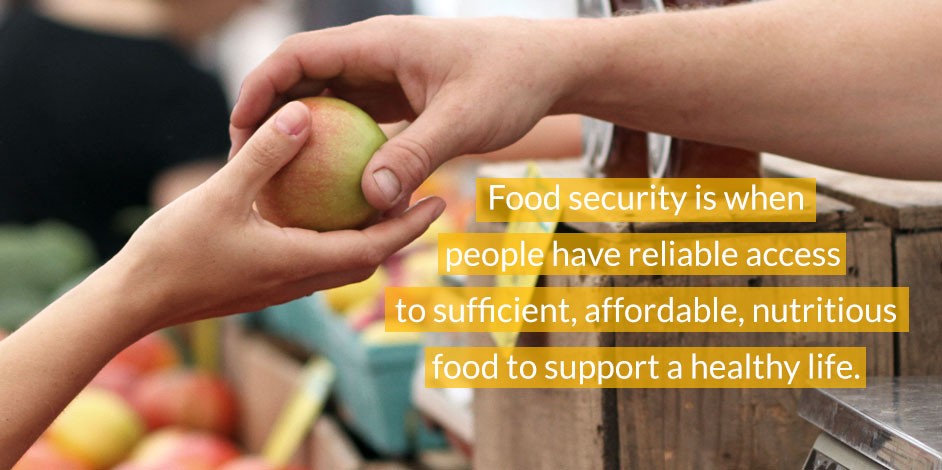Food Security in North Carolina
About 10.9% of North Carolina’s population, including 17% of children, experienced food insecurity in 2021 (Feeding America 2022). All North Carolina counties are affected by food insecurity, with rates generally higher in rural than urban or suburban areas.

Food security means access to sufficient, safe, and nutritious food to support an active and healthy life for all household members. Approximately 12.8% of American households (44.2 million people) experienced food insecurity at some point during 2022 because they had insufficient resources to obtain food (Rabbitt et al., 2023). This represents a sharp increase from 10.2% of households in 2021; contributing factors include inflation and loss of pandemic relief funds. Different groups are disproportionately impacted by food insecurity. According to Feeding America (2023), food insecurity for Blacks or Latinos is higher than for whites in more than 90% of counties nationwide; child food insecurity is about 13%, with rates higher than 40% in some counties; and over 90% of high food insecurity counties are rural. Food insecurity negatively impacts health due to the mental and physical stress it causes. Children are particularly susceptible to these impacts because their brains and bodies are still developing. Older adults are also vulnerable.
The Challenge
About 10.9% of North Carolina’s population, including 17% of children, experienced food insecurity in 2021 (Feeding America 2022). All North Carolina counties are affected by food insecurity, with rates generally higher in rural than urban or suburban areas. Rural food insecurity is exacerbated by factors such as limited capacity, resources, and transportation options compared to urban areas. Addressing food insecurity requires both short-term assistance programs (Supplemental Nutrition Assistance Program (SNAP), food banks, food pantries, etc.) and longer-term solutions to build self-sufficiency (education, addressing unemployment and housing affordability, increasing access to local foods, etc.). A sustainable local and regional food system that connects consumers to healthy foods and reduces waste through collaborative production, processing, and distribution networks is key to increasing food security.

Potential Responses
Short-Term
- Increase emergency assistance programs for the food-insecure
- Form partnerships to develop longer-term solutions to building food security (e.g., food-related workforce development)
- Increase resources and market access for small and minority farmers
- Initiate pilot projects to address gaps in local food systems (e.g., mobile markets, community-scale nutrition hubs, home delivery programs, etc.)
Medium-Term
- Implement strategies to connect consumers to fresh, healthy, locally produced foods (e.g., farmers’ markets, community gardens, grocery stores, food “rescue”/harvesting programs)
- Implement education, training, and other strategies to increase resilience and connect food-insecure people to societal networks
- Develop regional food security plans to coordinate local actions
- Develop regional food hubs to support food aggregation, storage, processing, and distribution
Long-Term
- Establish the key components of a sustainable, resilient regional food system (protected agricultural base, access to markets for producers and consumers, a pipeline of farmers, etc.)
- Address root causes of food insecurity (housing, transportation access, education, living wage jobs, etc.)
- Monitor impacts of other drivers of change on food security and the resilience of regional food systems
Key Stats
- About 10.9% (1.2 million) of North Carolina’s population, including 17% (394,000) of children, experienced food insecurity in 2021 (NCDHHS 2023).
- County food insecurity rates range from a low of 7.6% for Union County to a high of 18.0% for Robeson County. Only 11% of North Carolina counties have food insecurity rates less than 10%: Union (7.6%), Wake (8.5%), Cabarrus (8.9%), Currituck (8.9%), Mecklenburg (9.1%), Camden (9.4%), Orange (9.5%), Durham (9.6%), and Chatham (9.7%) (Feeding America 2022).
- North Carolina ranks in the top 10 nationally for production of a variety of foods, such as sweet potatoes (#1), turkeys (#2), hogs & pigs (#3), cucumbers (#3), livestock, dairy & poultry cash receipts (#6), blueberries (#7), and chickens (#8) (USDA-NASS and NCDACS 2022).

Example: Wake County
Wake County has the second lowest food insecurity rate (8.5%) among North Carolina counties. It has devoted considerable resources to increasing food security, aiming “to ensure that all residents have access to affordable, nutritious, and culturally relevant food.” In 2015, the County Board of Commissioners funded the development of Moving Beyond Hunger, a comprehensive food security plan led by the Wake County Food Security Working Group and Capital Area Food Network (the county’s food council). Completed in 2017, the plan established five strategies (ensure food access, communicate and educate, develop sustainable food supply, build economic opportunity, and lead through networks), five indicators of progress, and 41 recommended actions to carry out over three years. In 2023, the County partnered with the North Carolina Cooperative Extension Service to complete Creating a Resilient & Equitable Food System, an update to the 2017 plan. The update lays out new strategies and investments to “transition our current food security model from food charity to food resilience.”
Click here to complete our survey about North Carolina drivers of change!
References
Feeding America (2022). Hunger in America (website)
North Carolina Department of Health and Human Services (NCDHHS) (2023). State Action Plan for Nutrition Security 2023-2024
Rabbitt, Matthew P. et al. (2023). Household Food Security in the United States in 2022, USDA Economic Research Service, Report No. 325
USDA National Agricultural Statistics Service (USDA-NASS) and North Carolina Department of Agriculture & Consumer Services (NCDACS) (2022). 2022 North Carolina Agricultural Statistics
Wake County, NC (2017). Moving Beyond Hunger: Comprehensive Food Security Plan and Action Manual
Wake County, NC (2023). Moving Beyond Hunger: 2023 Wake County Food Security Plan Update

